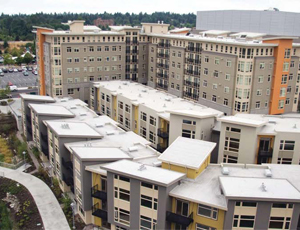This two-story, 75,000-sq-ft build-out was designed to achieve a platinum rating under the new LEED-CI Version 3.0 system, which was not released until the end of construction.

In order to be prepared for the new rating, James G. Davis Construction Corp. compiled the construction waste reports, documented all the indoor air-quality strategies with photographs throughout the project and verified that all material onsite complied with the new LEED standards and scorecard for the project.
The general contractor was the first in the country to use the v3.0 templates and LEED Online. In doing so, it was able to provide feedback to the Green Building Certification Institute during its roll-out of the new LEED Online system.
All of the materials used onsite were scrutinized for environmentally responsible characteristics. The elevator lobby, reception and conference areas are encased in 500-year-old gumwood that was salvaged from the bottom of the Tennessee River. Computer numerical controls guided the routing of the USGBC logo into a two-story section of the gumwood paneling.
Terrazzo flooring at the main entrance leads to the main conference rooms, which include custom-printed fabric paneling and recycled glass countertops. A large meeting table for the kitchen was custom designed and fabricated in Lancaster, Pa., out of a walnut tree salvaged from Vienna, Va.
Owner: U.S. Green Building Council, Washington, D.C.
General contractor: James G. Davis Construction Corp., Rockville, Md.
Architect: Envision Design, Washington, D.C.
Structural engineer: GHT Limited, Arlington, Va.
Mechanical and plumbing contractor: W.E. Bowers, Beltsville, Md.
Electrical contractor: J.E. Richards, Beltsville
Architectural millwork contractor: Columbia Woodworking, Washington, D.C.
Drywall contractor: Tri-State Drywall Inc., Rockville
All fabric panels are 100% recycled polyester. The modular carpet tile contains 60% recycled content and is made locally in Virginia. For storage purposes, the conference room chairs nest like shopping carts to save on storage space. More than 97% of construction waste was diverted from the landfill by the implementation of offsite sorting and recycling and/or material donation.
With an aggressive 12-month schedule, there were often more than 120 subcontractors onsite. James G. Davis Construction’s senior project manager spent 75% percent of his time onsite with the superintendents to ensure a smooth process. This also enabled the GC team to walk the site with the architect and engineer several times each week to make real-time decisions along with changes in order to keep the construction moving forward. The GC would then follow up with field reports documenting these changes and RFI resolutions. This strategy enabled construction to continue without delay.

Post a comment to this article
Report Abusive Comment